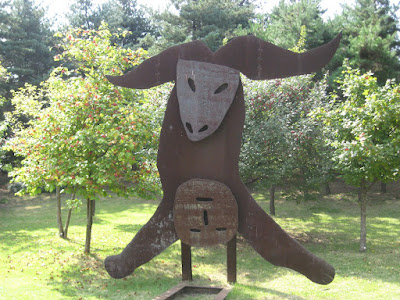
Above is the essential Olympic Park photo, taken in front of the "World Peace Gate" just outside Exit 1, Mongchontoseong Station of Line 8.
On Day 2 of my vacation, I made the long haul across town to Olympic Park, something I have been meaning to do--nearly an hour away. I have divided the trip into two posts, and you can see post number one, about the ancient history of the site, immediately below (or you can click here).
Before I came to Seoul, some people told me that trees and vast vast expanses of green would become a thing of my past--I have blogged severally with photos of the flowers and greenery in my daily jaunts, so that prediction was untrue. Here lays to rest the notion about vast green fields in Seoul--this field could fit seven soccer fields or more!

That's the gymnastics pavilion across the way, one of the venues, along with the swimming pool, velodrome and fencing hall, that flank the Han-Eul Plaza, famous for the obelisk below:


Additionally, the plaza contains the piece above, called 'Site for Expansion 88' by a Korean named Lee Chong-gak. The parabola thing is better, even though I don't know its name.
Olympic Park is indeed well-known for the Sculpture Park which forms part of its core. I am led to believe there are 200 or so sculptures in its confines, but somewhat fewer works of art. There is definitely a lot of crap, as there always will be when a some kind of committee determines what to include, and especially when they are aiming to express some grand vision or visualize some grand expression, or whatever.
I'm going to start strong and go down the list, though of course your mileage may vary. Easily the best piece in the park is this, and I could not find a plaque to tell you the name:

The red lips seal the deal. #2 in Tuttle's pantheon:

If you don't see the charm in that, then just click the red X and remember our time together on the blog as a brief, delightful, wistful crossing of paths moment--no blame, no recriminations, just a misunderstanding ...
#3, titled Dialogue, by Mohand Amara of Ethiopia:

I like these two, too, but I can't really say why:


"View to Ayacucho" by Peruvian Fabian Sanchez:

A coupla Korean dudes sitting around talking (apologies to John Ford Noonan):

The sk8r in me likes this piece, in part because of its scale, and in part because I dream of living in a house with a grass roof in Alaska or somewhere:
 |  |
Here is an example of something I disliked. It is titled "Space of a Dragon" by Polish artist Magdalena Abakanowicz. The artist's interpretation plaque reads:
A crowd of people or birds, insects or leaves, is a mysterious assemblage of varients of a certain prototype. A riddle of nature's abhorrence of exact repetition or inability to produce it.
Just as a human hand cannot repeat its own gesture, I invoke this disturbing law, switching my own immobile herds into that rhythm. "Space of a Dragon" is a group of 10 metaphoric animal heads emerging directly from the soil.

At the main entrance to the park, you will find the Peace Gate,

which has the Olympic flame in the center,

has its own interpretive plaque,

and is surrounded by a series of totems with traditional Korean masks.



At the far end of the broad Peace Plaza is the National Flags Plaza,


which abuts the Mongchon moat.

Near this area is the Seoul Olympic Museum of Art (W3,000 entry price, and not really worth it) as well as numerous concessionaires, including a "train ride", and some sculptures.




The park is well-marked, with several nice big billboards showing where everything is. This is a really nice park, but it's an hour away from me by subway, so I won't become a regular visitor until they finish line 9 through to Jamsil.



























